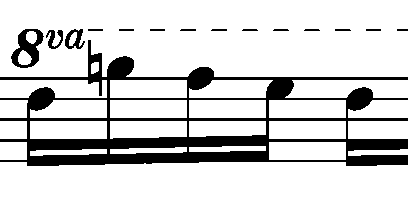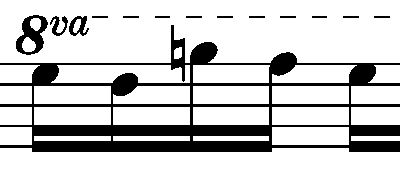Three practice tips for musicians that will break your brain
Do you ever practice something over and over and everything is going well, but then you hit a wall in your practice? Or something throws you off when you’re out of the practice room? Or just bored of the same practice strategies?
I have a few practice strategies for musicians that are definitely character building. In other words, they feel like they’re breaking your brain. What’s actually happening is strengthening the fortress around your skill by building the skill from different approaches and angles than what we’re used to as musically inclined practice room dwellers.
Included is a bonus practice in intentional distraction for after notes and details are learned that is much different than having someone around you make noise.
I’ve personally used the practice strategies I discuss or suggest (this goes for every post, every lesson, workshop, etc) - and yes, these have helped me and others, but these are deceptively challenging.
Let’s get at it!
Practice with different articulations
This technique is deceptive. It sounds easy, looks easy - how hard can it be? I know all the notes - it’s all good. That is, until we put it into action.
What this does is it throws a different parameter we’re not used to in the mix, so our mind has to manage an extra new thing - and this can really throw us off.
By getting a handful of different articulations on our technical passage well learned, it can help reinforce the notes and the evenness of the original passage. I’m not talking about doing it a couple times on a couple different articulations, tripping up, and calling it a day (and then complaining it doesn’t work - technique books challenge you like this for a reason) - I’m talking about learning them so you can switch to something else intentionally.
This can also help you become more adaptable as a player overall.
Start on a different part of the beat with a 4+1 pattern
You know when we have a group of sixteenth notes, and we practice them in a 4+1 pattern - the group of four and land on the first note of the next beat, and practice it that way?
(technically this can be applied to any number of groupings in time signatures - number of notes plus the first note of the next beat - I’m using 4+1 in sixteenths as an example here)
Try disregarding the visual groupings that sixteenth notes in 4/4 time provide us. Try a 4+1 pattern starting on the last note of the visual grouping, like in this example:
Starting on the last note of the four note grouping as your new start of the beat, will sound like this:
Then try it on different parts of the visual grouping:
To have it played like this:
Not so easy when it sounds and feels different is it? Especially when the metronome is going and the beat lands on the part of the beat we’re not used to being the beginning of the beat. Keep trying. Cycle through all of the notes in the groupings as the first note of the “beat”. Using this technique we can also narrow down any notes in the grouping that are where we trip up most - and then we can focus on them and iron them out.
Next try it like 8+1 so you can build the bridge to the next beat with this kind of practice. Keep adding groupings as necessary.
This technique is just to help build fluidity in a technical passage, and reinforcing what is already learned.
Playing on offbeats with the metronome
This technique I learned from one of my flute teachers who was in a flute and percussion duo - this was the first time I experienced an out of the box practice technique where it felt like I “broke my brain”.
Practice with the metronome clicking on the offbeats instead of on the beat. That’s it.
You may have to fight with yourself to remain playing on the beat in what normally feels like the offbeat for the metronome, but keep at it.
You're adding something different to the parameters of your practice, and once you can handle that, you build that reinforcement in that part, and become more adaptable as a player.
BONUS - Intentional distraction - this version is for when the part is already learned and you’re feeling fabulous about it in the practice room
This one can be wild to put into practice. Do you ever feel like you have something really down pat under your fingers and then you go to rehearsal, and someone trips up in the same passage and it completely throws you off? Try some intentional distraction practice.
Yes, try setting alarms for various times when you’re playing, have someone walk around you and be distracting, but for a very distracting experience, try this:
Throw on your favourite playlist on one of your preferred streaming platforms or a CD or whatever you use to listen to music.
Hit shuffle. Put the volume on so you can hear it, but still hear your metronome a little louder.
Put on the metronome, set your timer, and practice the passage. You’ll feel pulled—dragged even, to adhere to the tempo of the song you’re listening to, and not the metronome - stick to the metronome. If you keep falling into this trap, lower the volume of the music by a little bit - you can turn it up later.
What we’re doing is trying to ignore the distractions that will throw you off.
If the passage is not already properly learned, don’t do this particular distraction game. You don’t want to work rhythm and note mistakes into your playing. This is for when it’s learned, you can do it really well with the metronome, without the metronome, with other more “regular” distractions, but you keep getting thrown off if there’s a bigger distraction.
Ages ago, I used this to work on a fast and technically challenging repeated section in Maurice Ravel’s Ma Mère l’Oye, because I had it under my fingers in the practice room, but as a unit if one person got thrown off, others might get thrown off too (and we all know how difficult repeated technical passages can be.) Practicing with this style of intentional distraction worked wonders for focus. And as a performer, I like to prepare to expect and be ready to adapt to anything that might happen, and I encourage everyone to do the same within their own abilities.
Again, these practice approaches will feel uncomfortable at first, especially since we’re trained to adhere to what is on the page in front of us in the way that it looks. Here, we are disassembling that structure, and putting it all back together from a different approach to make the foundation that much stronger.
Give these a try, and if you find they helped, or have questions, I’d love to hear from you!
If you’re looking for a flute teacher, wanting to try flute lessons, and/or want to build your practice strategy toolbox, I have space available in my online studio - I would love to work with you! Click here for information on my online flute lessons, or alternatively, click here to contact me if you’d like to get started but don’t know what’s right for you!




